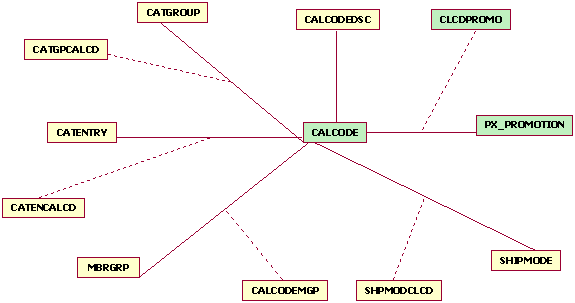Raising customer awareness of promotions
Currently, the advertisement of promotions, and the rendering of adjustments as the results of applying promotions to an order, are not part of the core promotion infrastructure. Both aspects are performed using Commerce mechanisms, and belong to the outmost triangle in the architecture diagram.
Making the connection
Promotions can be associated with catalog entries, categories, member groups and shipping modes for advertisement purposes. This is achieved through the CALCODE and related tables. The following diagram shows the tables used to establish these relationships.

the tables displayed in green are mandatory for the integration between the promotion engine and WebSphere Commerce, since each active promotion is implemented as a single calculation code in Commerce. The PX_PROMOTION table contains the definition of promotions. All of the rest are optional and used solely for promotion advertising purposes. Examples can be found in the starter stores, such as CommerceDirect, that shows how to advertise your promotions to shoppers based on these relationships.
The guidelines are:
- Customer viewable short and long descriptions of a promotion should go into the CALCODEDSC table
- If you want your promotion to be advertised alongside with a catalog entry, associate it with the catalog entry by creating a relationship (CATENCALCD) between CALCODE and CATENTRY.
- If you want your promotion to be advertised alongside with a category, associated with with the catgroup entry by creating a relationship (CATGPCALCD) between CALCODE and CATGROUP.
- If your promotion targets a particular customer segment, make the association (CALCODEMGP) between MBRGRP and CALCODE.
- If your promotion applies to a particular shipping mode, make the association (SHPMODCLCD) between SHIPMODE and CALCODE.
Showing the results
Currently, only monetary adjustments on an order and its order items can be displayed using the same mechanism as any order and order item adjustments. Samples of this can be found in starter stores such as ConsumerDirect.
Related concepts